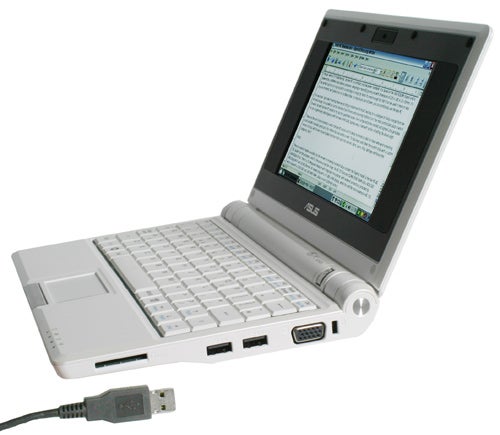
The screen is 7-inches diagonally with LED back lighting and has a resolution of 800 x 480 pixels.

True, the more expensive rivals come preloaded with Microsoft Windows XP or Vista and feature a range of superior technical specs … but our review of the Asus Eee PC shows this tiny white titan packs an impressive punch. The next closest competitor to the Eee PC would be traditional ultraportables like the Toshiba Portege R500 ($2,000) and the Sony VAIO TZ ($3,000). Weighing in at just two pounds and delivering a performance level similar to a full-featured budget notebook, the only notebook that comes close to “directly” competing with the Eee PC is the Fujitsu LifeBook U810 tablet PC … which retails for more than $1,000 at the time of this writing. The design of the Eee PC is something truly unique in the market. In short, the build quality is quite high despite the low cost. Lifting the display cover you find the amazingly small keyboard surface and even smaller touchpad resting below the recessed display and speakers. The case seams match up with reasonably tight tolerances, plastics feel thick (though the pearl-like white plastics look cheap) and the display hinges are molded into body with the battery. The designers at Asus had no easy task creating an attractive ultraportable notebook while also making it cheap to produce. Weight: approximately 2 lbs with battery, 2.5 lbs travel weight with AC adapter.

Battery: 4-cell 5200 mAh 7.4V Li-Ion (rated at 3.5 hours).Ports: 3 USB 2.0, 1 VGA monitor out, headphone jack, microphone input, SD card reader (SDHC compatible), Kensington lock slot, Ethernet 10/100.Screen: 7-inch screen with 800 x 480 resolution.Storage: 4GB of Flash-based storage (SSD).


 0 kommentar(er)
0 kommentar(er)
